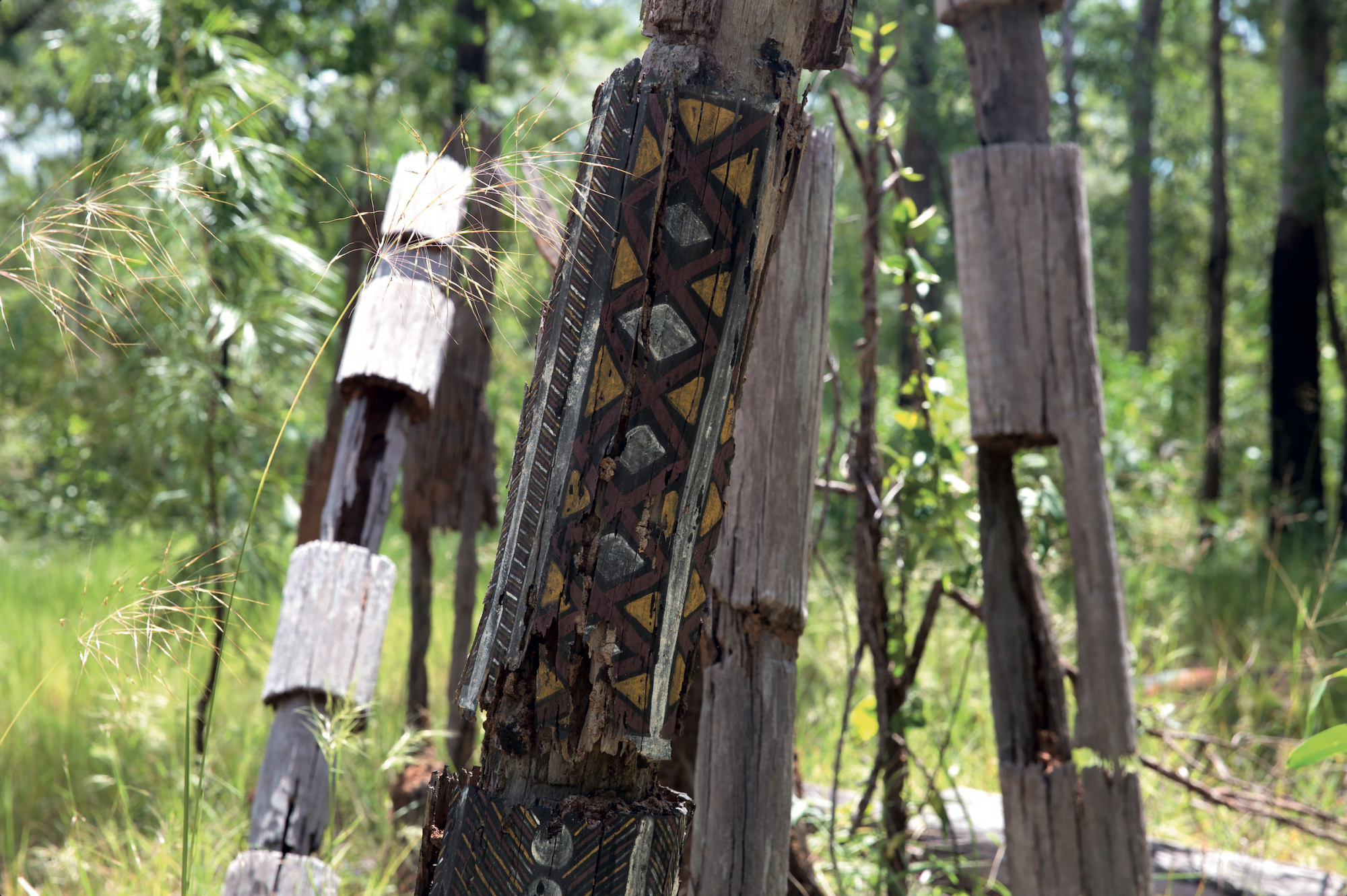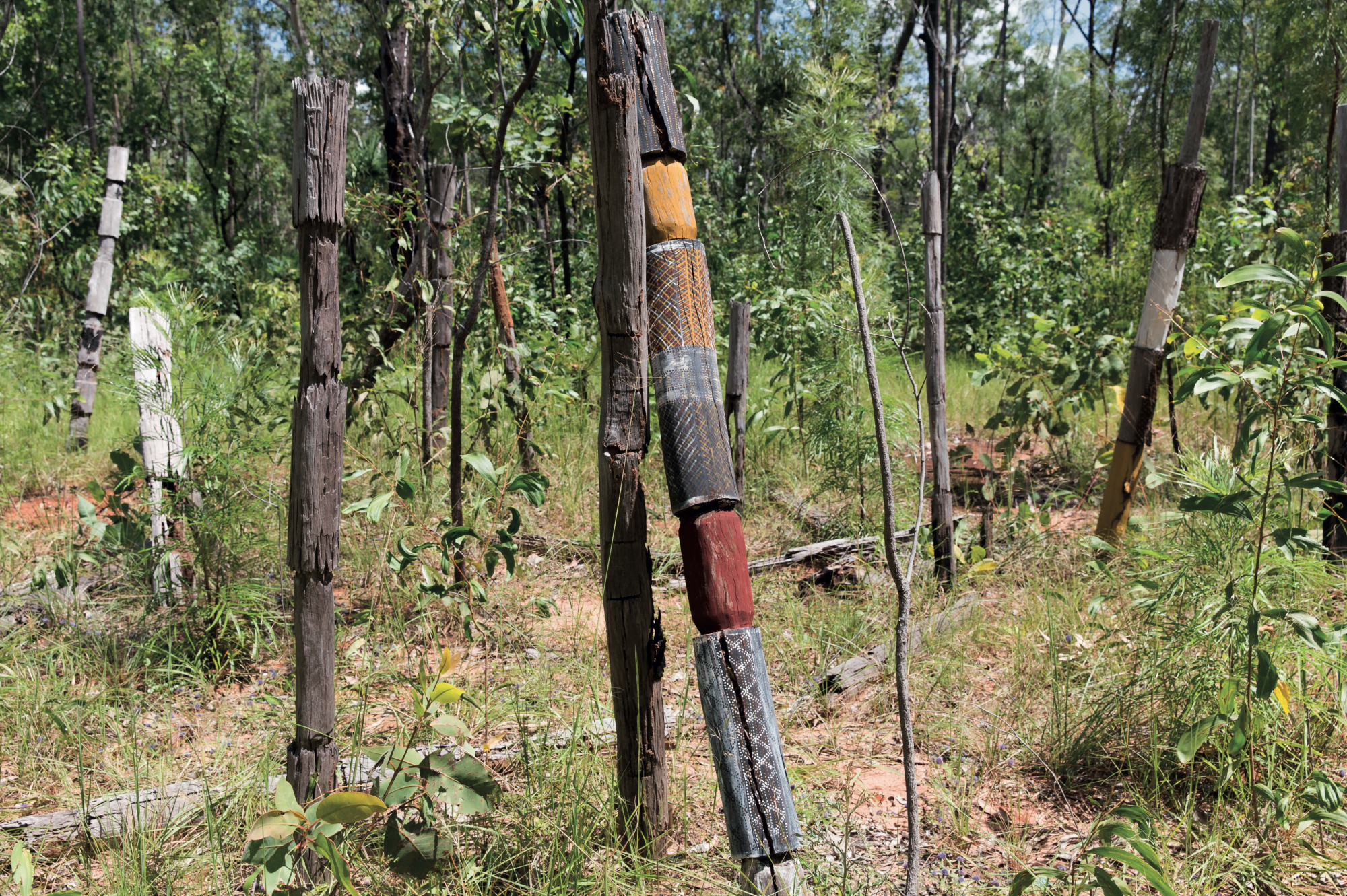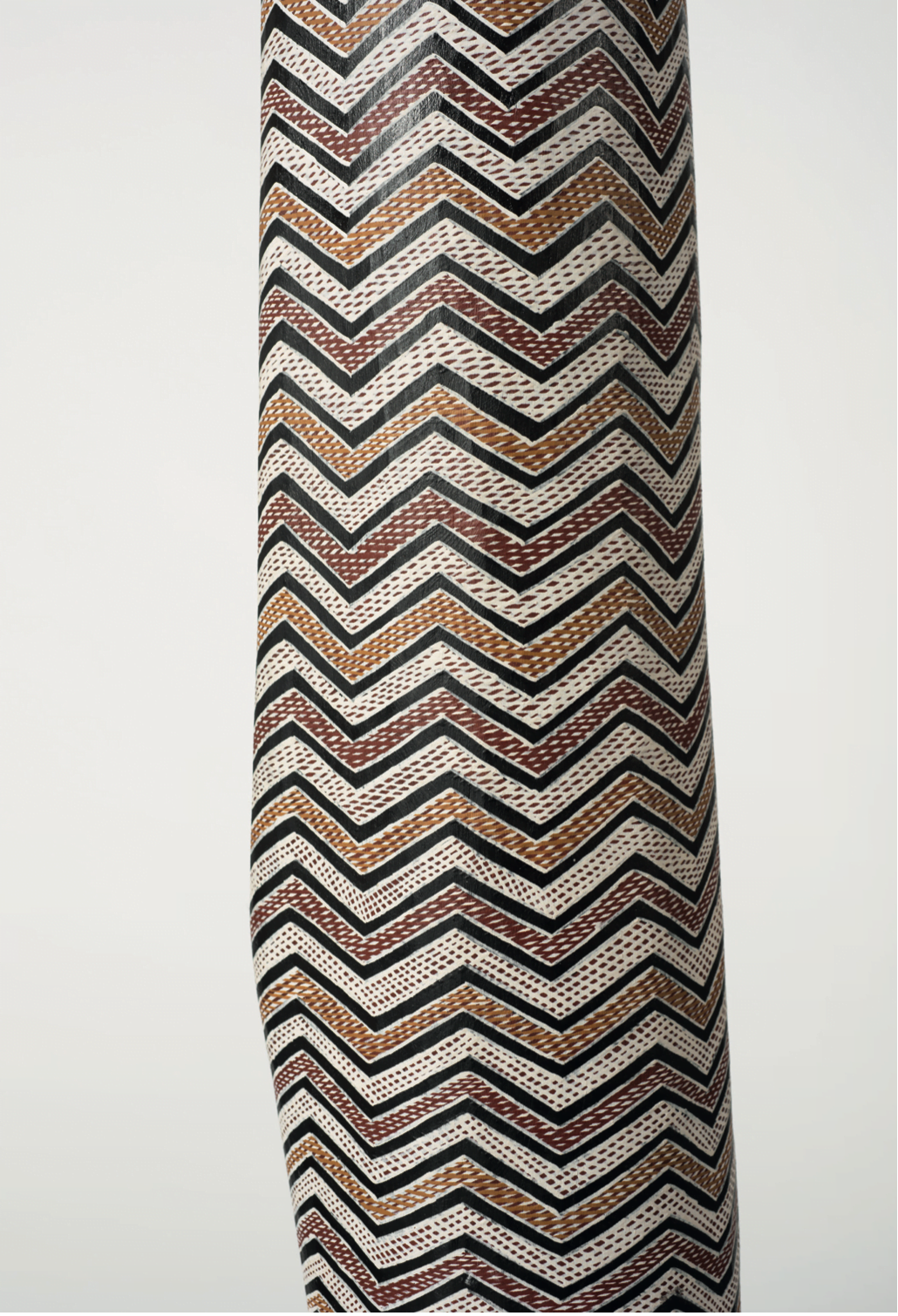Pukumani—
Pedro Wonaeamirri
Ngawulayapunjami japumpunuma punjami, Ngawulayapunjami japumpunuma punjami, Ngawulayapunjami japumpunuma, punjami, pumpi, wiya . . . Ngawulayapunjami japumpunuma punjami, Ngawulayapunjami japumpunuma punjami, Ngawulayapunjami japumpunuma punjami, pumpi, wiya . . . Ngawulayapunjami japumpunuma, punjami, pumpi, wiya
Old Tiwi songline.
Purukuparli calling out telling the world:
‘now my son is dead, now we all have to follow him’.
When a Tiwi person dies, a time called Pukumani begins. At the start there is a smoking ceremony to cleanse areas where the person lived and worked; the funeral when the body is buried; then after some time a small ceremony to start the making of the tutini (Pukumani poles); and finally the main Pukumani ceremony where the spirit is put to rest.
Six months or a year after a person passes, the family of the deceased begin to organise the Pukumani ceremony. During Pukumani, we do not use this person’s name, even people who hold that name are called by their middle name. The Pukumani ceremony marks the end of this time, six months or a year after the funeral. After the main ceremony the name comes back and Pukumani for that person is over.
The nieces and nephews who are the close family from the father’s side (in Tiwi way these are also the children, like ‘son’ and ‘daughter’) first organise a small ceremony to start things off. This little ceremony is sometimes organised four weeks before the main ceremony – this is the beginning. The sons and daughters dance with a tomahawk, lighter1 and white ochre. When dancing they give these things to the workers for the main Pukumani ceremony – these workers are always the in-laws of the deceased. There is a special dance for the giving of the tomahawk, lighter and white ochre – each has their own separate song and dance.
It is the in-laws who are commissioned to make Pukumani poles and do all the work in preparation for the final ceremony. When they are given the tomahawk these workers go out and cut the timber for making the tutini and shelter. The tomahawk is to cut the wood and the lighter is to burn and prepare the wood. It is also used to burn the yellow ochre and make the red colour. The ochre is to paint the poles, tunga (bark bags) and the bodies of the dancers.
When the close family are ready, they ask the workers to begin making the shelter. Close family we call warnatawi, which means father and aunty of the deceased person. It has been very important since Parlingarri (olden days) until today, that the close relatives do not work, because they are in Pukumani. It is taboo and they are grieving. During the time between the little ceremony and main ceremony, close family should observe grieving behaviour. In Parlingarri, close family could not work, travel anywhere or go hunting and warnatawi are even forbidden to touch food.
The workers prepare an area for the ceremony that has been selected by the close family. For example, when I organised a Pukumani ceremony for my son, I selected a space next to my house, in a spot where you can see over the ocean to our Country, then my son’s in-laws built a shade there. They start by collecting materials to build the shade. This includes forked timber lengths that we call rails or in Tiwi language, ‘bubliey’. We put six or nine of these upright in the ground in a square shape as posts to support straight rails hung between these forks. Once the wood frame is built then we use arliba (coconut leaves) to cover the top and create the shade under which we will yoi (dance). The workers then collect sand from the beach to prepare the ground under the shade. We do this for dancing and also to remember Purukuparli, who danced down the beach towards the sea with his baby Jinani during the first Pukumani ceremony. The commissioned tutini are placed upright in the ground at one end of the prepared area. Once the workers have finished the poles, built the shade and prepared the ground for dancing, the ceremony is ready to begin.
Always in preparation for the ceremony we do jilamara – body painting. We always use natural ochres from Melville Island to paint ourselves: turtiyangini (white), tunuwuni (black charcoal), arrikininga (yellow) and yarringa (red). The red is yellow ochre that we have cooked on the fire. The design goes on the poles, tunga (bark bags) that are made for the ceremony and the bodies of the family. The body painting, the ceremonial ornaments like the pamajini (armband), and tokwayinga (feather ball) are used to disguise ourselves from the spirit of the dead, ‘mopartiti’. When
we are dancing all painted up, we are disguising ourselves from the spirit world. That is the meaning of the word jilamara: design that we paint on ourselves to disguise ourselves. Now we use these design styles to make art at the art centre and still for ceremony as well. When individuals are all painted up the designs are never the same. Each person has their own unique jilamara that is based on how they connect to the deceased and other things, like their animal totem.
The ceremony always starts in the morning with a smoking for cleansing the area before entering the dancing area. We burn the kutukuni (ironwood) leaves and circle the smoke together as a group calling out to the deceased spirit. The dancing goes all day and finishes in the afternoon. Everyone takes part in the ceremony in different ways. Some family members are like leaders and they call out to different groups to come forward and dance. Everyone on the Tiwi Islands is given an animal totem at birth based on their father’s family. For example, a leader of the ceremony can call all people with brolga totem to come forward and dance jilarti (brolga). The ceremony continues with dancers coming forward and dancing different totems to the rhythm of the whole group clapping their hands together as one. The groups dance towards the Pukumani poles and sometimes the family will put a photo of the deceased person on one of the poles for everyone to look at as they sing and dance. When there is a ceremony there is always a singer chosen who is a strong cultural leader, who knows all the different songlines. Totem dance is different to the dance of how you are related to the deceased person. Then when you dance that connection song, the totem comes in with a separate song. Dancing for a funeral is often shorter than when we dance for Pukumani; it is always much longer and about our totem, as well as how we are related to the deceased. In a funeral you cannot dance for your mother, or your uncle (mother’s brother) or your brothers and sisters from your mother’s tribe. Dancing for Pukumani ceremony is different. The Pukumani ceremony is for everyone to dance and get involved and connect with the spirit of the deceased – to let go of that person and finish the grieving process.
The in-laws help throughout the ceremony, continually smoothing the sand area with a rake for the next round of dancers. At the end of the yoi (dance) in the afternoon, the in-laws are paid for their work by the immediate family. Before they had money, long time ago they used to give ceremonial ornaments, spears and sometimes young women – now it is just money. One at a time the in-laws collect money from the family. With a special song and special dance, they come forward at the end of the ceremony and collect their pay. When these arrangements finish, the warnatawi (immediate family – father and aunty) can eat and touch food again – it means no more Pukumani. All the family then have yinkiti (food) together.
In Parlingarri (old times), the poles were always taken to the grave on that same day. Now sometimes on the same day or next day the in-laws take the poles from their place under the shade area. They are taken to the person’s grave site and erected around the grave. The poles are left in this spot in the bush.
No tribe or clan group can repaint or replace another pole;
they are left to age over time.
I had ceremony for my mother, then I had ceremony for my father and now I have had one for my son. I was the leader of these ceremonies because of my close relationship to these family members. Like for my ceremony, I grieve in sadness but also remember and just let it all go, all the time remembering. For the Tiwi, Pukumani ceremony is about letting go, but always remembering. We believe that it is a way to send the spirit back to their Country. From then and forever, whenever we go to this Country we always call out to the spirits of those relatives and let them know we are entering their place. We say hello, let them know why we are there and introduce any visitors we might have with us. They are at rest on Country, but always there. If we don’t call out to them, then we believe something bad will happen.
Compiled by Will Heathcote with Pedro Wonaeamirri at Jilamara Arts and Crafts Association, Milikapiti.
Resource for spelling and translation:
Jennifer R Lee. Ngawurranungururumagi Nginingawila Ngapangiraga: Tiwi English Dictionary. Bathurst Island, NT: Nguiu Nginingawila Literature Production, 1993.

Photograph: Will Heathcote

Photograph: Will Heathcote

Garrapara 2007

Garrapara 2007

Garrapara (detail) 2007
1. Today whenever we go out hunting, we call out to see if everything Today we give modern-day lighters, but before lighters they used to give out boxes of matches and long before that fire sticks. When we say lighter, we mean fire as a gift to the in-laws.
2. In Tiwi way, because Purukuparli and Japarra are brothers they call Jinani ‘our son’. The boy connects with Japarra through the father’s side, therefore Japarra calls Jinani ‘son’ and Janini calls Japarra ‘father’. When siblings of the same gender have children on the Tiwi Islands they are also their children and they call their aunties and uncles ‘mum’ and ‘dad’. This is the Tiwi way.
